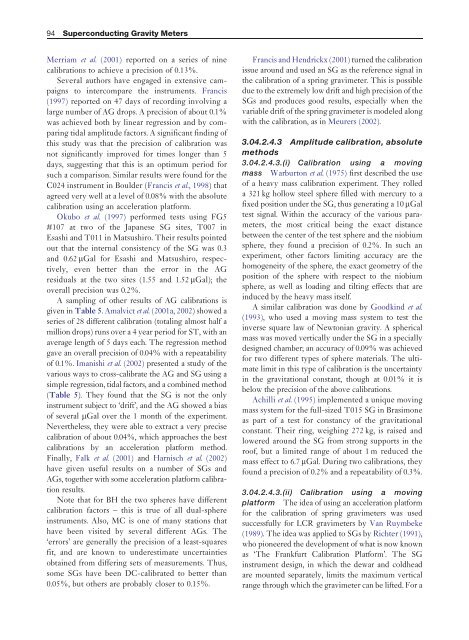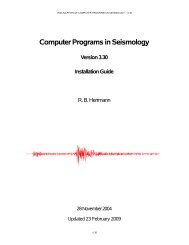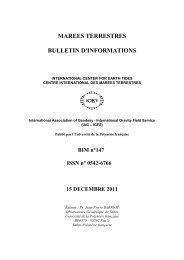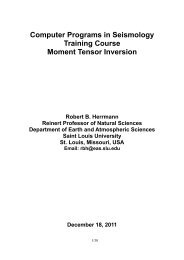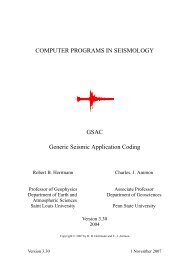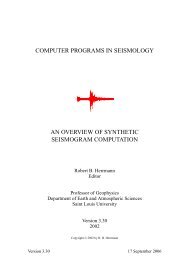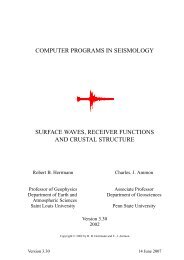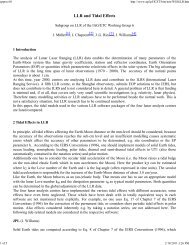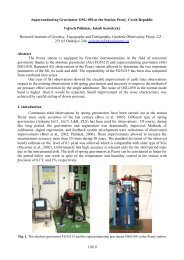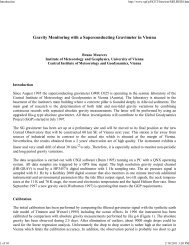3.04 Gravimetric Methods – Superconducting Gravity Meters
3.04 Gravimetric Methods – Superconducting Gravity Meters
3.04 Gravimetric Methods – Superconducting Gravity Meters
You also want an ePaper? Increase the reach of your titles
YUMPU automatically turns print PDFs into web optimized ePapers that Google loves.
94 <strong>Superconducting</strong> <strong>Gravity</strong> <strong>Meters</strong><br />
Merriam et al. (2001) reported on a series of nine<br />
calibrations to achieve a precision of 0.13%.<br />
Several authors have engaged in extensive campaigns<br />
to intercompare the instruments. Francis<br />
(1997) reported on 47 days of recording involving a<br />
large number of AG drops. A precision of about 0.1%<br />
was achieved both by linear regression and by comparing<br />
tidal amplitude factors. A significant finding of<br />
this study was that the precision of calibration was<br />
not significantly improved for times longer than 5<br />
days, suggesting that this is an optimum period for<br />
such a comparison. Similar results were found for the<br />
C024 instrument in Boulder (Francis et al., 1998) that<br />
agreed very well at a level of 0.08% with the absolute<br />
calibration using an acceleration platform.<br />
Okubo et al. (1997) performed tests using FG5<br />
#107 at two of the Japanese SG sites, T007 in<br />
Esashi and T011 in Matsushiro. Their results pointed<br />
out that the internal consistency of the SG was 0.3<br />
and 0.62 mGal for Esashi and Matsushiro, respectively,<br />
even better than the error in the AG<br />
residuals at the two sites (1.55 and 1.52 mGal); the<br />
overall precision was 0.2%.<br />
AsamplingofotherresultsofAGcalibrationsis<br />
given in Table 5. Amalvict et al. (2001a, 2002) showed a<br />
series of 28 different calibration (totaling almost half a<br />
million drops) runs over a 4 year period for ST, with an<br />
average length of 5 days each. The regression method<br />
gave an overall precision of 0.04% with a repeatability<br />
of 0.1%. Imanishi et al. (2002) presented a study of the<br />
various ways to cross-calibrate the AG and SG using a<br />
simple regression, tidal factors, and a combined method<br />
(Table 5). They found that the SG is not the only<br />
instrument subject to ‘drift’, and the AG showed a bias<br />
of several mGal over the 1 month of the experiment.<br />
Nevertheless, they were able to extract a very precise<br />
calibration of about 0.04%, which approaches the best<br />
calibrations by an acceleration platform method.<br />
Finally, Falk et al. (2001) and Harnisch et al. (2002)<br />
have given useful results on a number of SGs and<br />
AGs, together with some acceleration platform calibration<br />
results.<br />
Note that for BH the two spheres have different<br />
calibration factors <strong>–</strong> this is true of all dual-sphere<br />
instruments. Also, MC is one of many stations that<br />
have been visited by several different AGs. The<br />
‘errors’ are generally the precision of a least-squares<br />
fit, and are known to underestimate uncertainties<br />
obtained from differing sets of measurements. Thus,<br />
some SGs have been DC-calibrated to better than<br />
0.05%, but others are probably closer to 0.15%.<br />
Francis and Hendrickx (2001) turned the calibration<br />
issue around and used an SG as the reference signal in<br />
the calibration of a spring gravimeter. This is possible<br />
due to the extremely low drift and high precision of the<br />
SGs and produces good results, especially when the<br />
variable drift of the spring gravimeter is modeled along<br />
with the calibration, as in Meurers (2002).<br />
<strong>3.04</strong>.2.4.3 Amplitude calibration, absolute<br />
methods<br />
<strong>3.04</strong>.2.4.3.(i) Calibration using a moving<br />
mass Warburton et al. (1975) first described the use<br />
of a heavy mass calibration experiment. They rolled<br />
a 321 kg hollow steel sphere filled with mercury to a<br />
fixed position under the SG, thus generating a 10 mGal<br />
test signal. Within the accuracy of the various parameters,<br />
the most critical being the exact distance<br />
between the center of the test sphere and the niobium<br />
sphere, they found a precision of 0.2%. In such an<br />
experiment, other factors limiting accuracy are the<br />
homogeneity of the sphere, the exact geometry of the<br />
position of the sphere with respect to the niobium<br />
sphere, as well as loading and tilting effects that are<br />
induced by the heavy mass itself.<br />
A similar calibration was done by Goodkind et al.<br />
(1993), who used a moving mass system to test the<br />
inverse square law of Newtonian gravity. A spherical<br />
mass was moved vertically under the SG in a specially<br />
designed chamber; an accuracy of 0.09% was achieved<br />
for two different types of sphere materials. The ultimate<br />
limit in this type of calibration is the uncertainty<br />
in the gravitational constant, though at 0.01% it is<br />
below the precision of the above calibrations.<br />
Achilli et al. (1995) implemented a unique moving<br />
mass system for the full-sized T015 SG in Brasimone<br />
as part of a test for constancy of the gravitational<br />
constant. Their ring, weighing 272 kg, is raised and<br />
lowered around the SG from strong supports in the<br />
roof, but a limited range of about 1 m reduced the<br />
mass effect to 6.7 mGal. During two calibrations, they<br />
found a precision of 0.2% and a repeatability of 0.3%.<br />
<strong>3.04</strong>.2.4.3.(ii) Calibration using a moving<br />
platform The idea of using an acceleration platform<br />
for the calibration of spring gravimeters was used<br />
successfully for LCR gravimeters by Van Ruymbeke<br />
(1989). The idea was applied to SGs by Richter (1991),<br />
who pioneered the development of what is now known<br />
as ‘The Frankfurt Calibration Platform’. The SG<br />
instrument design, in which the dewar and coldhead<br />
are mounted separately, limits the maximum vertical<br />
range through which the gravimeter can be lifted. For a


